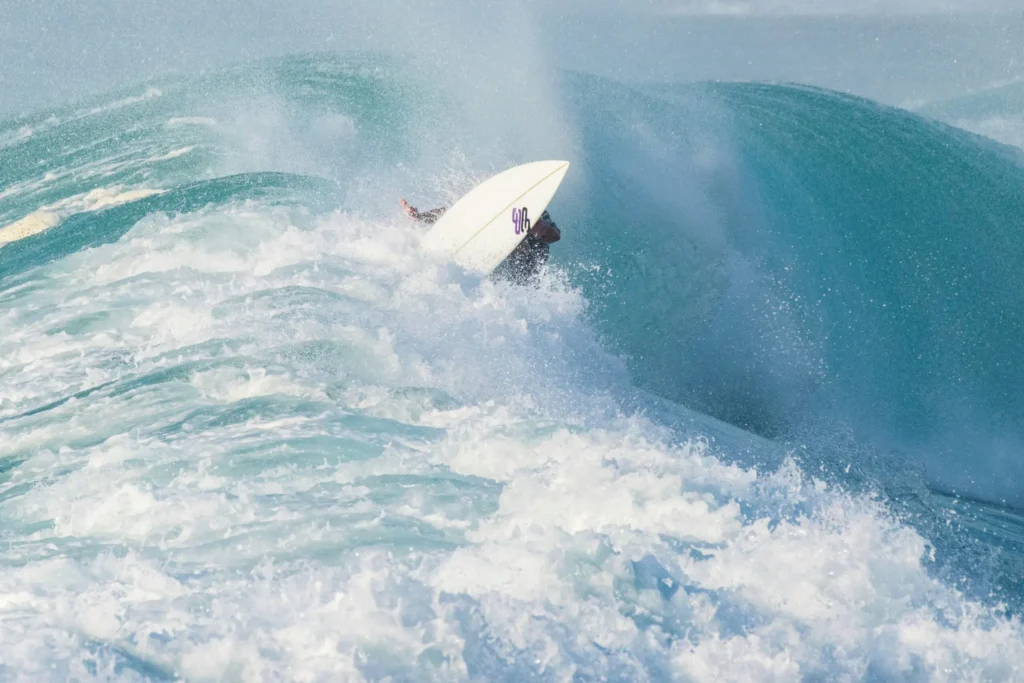Introduction:
Are you tired of feeling like your surfboard is holding you back on the waves? Do you dream of carving through water with unparalleled precision, achieving lightning-fast speeds, and executing maneuvers you’ve only dared to imagine? The good news is, these dreams are no longer just fantasies. Recent innovations in surfboard design are revolutionizing the way we experience the ocean, empowering surfers of all levels to push the boundaries of what’s possible.

Table of Contents
This article delves into the three game-changing innovations that are redefining top surfboard performance:
- Hydrodynamic Hull Designs: These innovative shapes are engineered to slice through water with minimal resistance, maximizing speed and control.
- Advanced Fin Technology: From optimized fin placement to bio-inspired designs, these advancements enhance maneuverability, stability, and overall performance.
- Cutting-Edge Materials: From lightweight and responsive carbon fiber to eco-friendly foam cores and nano-coatings, these materials offer a winning combination of strength, durability, and sustainability.
Let’s dive deeper into each of these innovations and explore how they can elevate your surfing experience.

Hydrodynamic Hull Designs: The Science of Speed and Control
Gone are the days of bulky, drag-inducing surfboards. Hydrodynamic hull designs are revolutionizing the way we interact with waves, offering unparalleled speed, maneuverability, and control. These innovative shapes are engineered with meticulous attention to detail, incorporating principles of fluid dynamics to optimize water flow and minimize resistance.
Streamlined Shapes for Faster Speeds
Imagine catching a wave and feeling an immediate surge of acceleration as you effortlessly glide across the water’s surface. This is the magic of streamlined hull designs. By reducing the board’s contact area with the water, these shapes allow you to harness more of the wave’s energy, translating into faster takeoffs and higher top speeds.
Reduced Drag for Improved Maneuverability
Beyond speed, hydrodynamic hull designs also enhance maneuverability by minimizing the water’s grip on the board. This translates into quicker response to your movements, smoother transitions between turns, and enhanced control in critical sections of the wave. Whether you’re carving tight turns or navigating through choppy conditions, you’ll experience a newfound level of precision and control.
Customized Contours for Different Wave Types
One size doesn’t fit all when it comes to wave riding. Hydrodynamic hull designs now offer customized contours to match specific wave conditions, ensuring optimal performance in a variety of surf.
- Beach Breaks: Flatter bottom contours promote faster planing and improved wave catching ability, perfect for smaller, less powerful waves.
- Point Breaks: Slight concave contours provide enhanced hold and drive on longer, rolling waves, allowing you to maintain speed and flow through drawn-out turns.
- Big Waves: Deep concave contours offer maximum control and stability in powerful surf, ensuring you can handle the force of large waves with confidence.
By choosing a board with the right hull contour, you’ll optimize your performance across various surf conditions, unlocking your full potential in any wave.

Advanced Fin Technology: The Art of Maneuverability and Control
Fins are the unsung heroes of surfboard performance, playing a crucial role in steering, stability, and overall control. Recent advancements in fin technology are taking maneuverability and control to new heights, allowing surfers to execute maneuvers with greater precision and finesse.
Optimized Fin Placement and Design
The placement and design of fins have a significant impact on how a surfboard performs. Advanced fin technology utilizes sophisticated algorithms and hydrodynamic principles to optimize fin placement, ensuring the perfect balance between speed, maneuverability, and stability. Additionally, bio-inspired fin designs, such as those mimicking the shape and flexibility of whale fins, are enhancing turning capabilities and overall efficiency.
Adaptable Fin Systems
Gone are the days of being limited to a single fin setup. Adaptable fin systems allow surfers to customize their fin configuration based on wave conditions and personal preferences. Whether you’re looking for maximum speed, tight turning, or a balance of both, these versatile systems provide the flexibility to adapt your board to any situation.
High-Performance Fin Materials
The materials used in fin construction also play a crucial role in performance. Advanced composites and lightweight materials offer a winning combination of strength, flexibility, and responsiveness, ensuring that your fins can handle the demands of high-performance surfing.

Cutting-Edge Materials: The Future of Sustainability and Performance
The future of surfboard design is not only about performance but also about sustainability. Innovative materials are being incorporated into surfboard construction, offering a winning combination of strength, durability, and environmental consciousness.
Carbon Fiber for Strength and Flexibility
Carbon fiber has become a game-changer in surfboard construction. This lightweight yet incredibly strong material offers a superior strength-to-weight ratio, allowing for thinner, more responsive boards without compromising durability. Additionally, carbon fiber’s unique flex patterns enhance the board’s responsiveness, allowing you to feel more connected to the wave.
Eco-Friendly Foam Cores
Sustainability is making waves in the surfboard industry. Eco-friendly foam cores, made from recycled materials or sustainable sources, offer a guilt-free alternative to traditional foam cores. These eco-friendly options provide comparable or even improved performance while reducing the environmental impact of surfboard production.
Nano-Coatings for Increased Durability
Nano-technology is taking surfboard protection to the next level. These advanced coatings provide superior resistance to dings and scratches, ensuring that your board looks and performs its best for longer. Additionally, nano-coatings offer improved UV protection and enhanced water repellency, further extending the lifespan of your surfboard.
Smart Materials for Adaptive Performance
Imagine a surfboard that adapts to your riding style and wave conditions. Smart materials are making this a reality, offering a glimpse into the future of surfboard design. Shape-memory alloys allow for adjustable flex, piezoelectric materials can harvest energy from wave movement, and temperature-responsive polymers can alter the stiffness of the board based on water temperature. These innovative materials are pushing the boundaries of what’s possible in surfboard design, offering surfers unprecedented levels of performance and customization.
Composite Blends for Improved Buoyancy
Innovative composite blends are redefining buoyancy in surfboards. These blends combine materials like carbon-kevlar, basalt-epoxy, and cork-polymer to create boards with enhanced buoyancy, shock absorption, and overall performance. These advancements offer surfers a wider range of options to choose from, ensuring they can find the perfect board for their individual needs and surfing style.

The Future of Surfing: A World of Endless Possibilities
The relentless pursuit of innovation is transforming the world of surfing. From hydrodynamic hull designs and advanced fin technology to cutting-edge materials and groundbreaking technologies, the future of surfboard performance is brighter than ever. By embracing these advancements, surfers can unlock their full potential and experience the thrill of riding waves like never before.
Whether you’re a seasoned pro or a weekend warrior, these innovations offer something for everyone. So, grab your board, embrace the possibilities, and get ready to experience the magic of surfing in a whole new way.
Fin Innovation: Custom and 3D-Printed Fins
Importance of Fin Shape and Placement
A surfboard’s fins are essential to its performance. Adjustments to fin size, shape, and placement influence stability, speed, and maneuverability, allowing surfers to adapt their boards to various conditions.
Advantages of 3D-Printed and Custom Fin Solutions
3D-printed fins offer precision and customization, letting surfers tailor fin design to suit specific wave conditions and personal preferences. This innovation allows for on-demand fin replacements and experiments with unique configurations.
Innovation 4: Smart Surfboards with Embedded Technology
Evolution of “Smart” Boards in Surfing
Smart surfboards come equipped with sensors and technology that track key metrics, merging traditional surfing with advanced data science. These boards provide real-time data, helping surfers understand and improve their performance.
Benefits of Real-Time Data for Surfers
With immediate feedback on factors like speed, wave frequency, and maneuver dynamics, smartboards offer actionable insights that can enhance a surfer’s technique and style.
GPS Tracking and Wave Analytics
Tracking Location, Speed, and Wave Data
GPS technology allows surfers to track their location, ride speed, and wave conditions, helping them optimize each ride. This data enables surfers to analyze their performance and make more informed choices in future sessions.
Using Analytics to Improve Wave Selection and Technique
By studying wave patterns and data analytics, surfers can develop a more strategic approach to wave selection and maneuver execution, making each ride more purposeful and exhilarating.
Pressure and Flex Sensors
The Role of Flexibility in Board Performance
Flexibility in a surfboard affects how it handles turns and impacts. Pressure sensors embedded in smartboards provide valuable data on flex and stability, helping surfers understand how to position their weight for optimal balance.
Insights from Pressure Data on Foot Positioning
Pressure data also reveals foot positioning, which is key to mastering control. This information helps surfers make minor adjustments to stance and movement, refining their approach with each ride.
Temperature and Environmental Condition Sensors
Monitoring Board and Ocean Conditions for Performance
Temperature sensors track both the board’s and water’s temperature, helping surfers adjust their technique based on changing conditions. Environmental data aids in maintaining peak board performance.
Preserving Board Integrity with Condition Data
Knowing the environmental conditions can help surfers better care for their boards, prolonging durability by preventing exposure to extreme temperatures and moisture levels.
Mobile App Integration for Surfboards
Accessing Surf Data and Analytics via Apps
Mobile apps connected to smartboards allow surfers to access performance metrics directly from their devices. This instant access makes it easy to track improvements and set new goals.
Enhancing Performance with Feedback from Connected Devices
App-based feedback lets surfers review their data post-session, making adjustments based on insights gained. This fosters continuous improvement and a personalized approach to skill development.
Data Analysis for Skill Improvement
How Data-Driven Insights Improve Surfing Skills
Data analysis allows surfers to identify strengths and weaknesses, tailoring their practice to improve specific areas. This methodical approach leads to measurable progress over time.
Leveraging Analytics to Track Progress and Technique
Analytics provide surfers with a quantifiable way to track their performance, highlighting improvements and pinpointing areas for further development.
Advantages and Challenges of High-Tech Surfboards
Pros of Integrating Technology into Surfboards
Technology enhances surfing by providing real-time feedback, tracking, and analysis, allowing surfers to hone their skills with precision.
Addressing Potential Drawbacks of High-Tech Boards
Some surfers find that technology can distract from the pure experience of surfing. Additionally, these advanced boards may be more expensive and require maintenance to keep sensors functioning.
Future Trends in Surfboard Innovation
Predicting New Materials and Smart Technologies
Future surfboards may integrate more sustainable materials, smarter technologies, and enhanced hydrodynamic designs, bringing new possibilities to the sport.
Envisioning the Next Wave of Surfing Equipment
The future of surfing equipment will likely blend sustainability with performance, reshaping the industry with innovative materials and designs.
Sustainability and the Surfing Community
Fostering Eco-Conscious Choices among Surfers
As awareness grows, more surfers are choosing eco-friendly options, supporting companies that prioritize sustainability and ocean health.
The Cultural Shift Toward Sustainable Surfing
This shift reflects a deeper connection to nature, encouraging surfers to care for the environments they enjoy.
Conclusion
These three innovations—sustainable materials, hydrodynamic designs, and smart technology—are transforming the surfing world. As the sport progresses, these advancements will continue to enhance performance while aligning with values of environmental responsibility.
Frequently Asked Questions (FAQ)
1. How do eco-friendly materials affect surfboard performance?
Eco-friendly materials often improve buoyancy and flexibility, offering comparable, if not superior, performance to traditional materials.
2. Are smart surfboards suitable for beginner surfers?
Yes, beginners can benefit from smart surfboards, as they provide data on basic metrics, aiding in skill development.
3. What is the importance of hydrodynamic design in surfboards?
Hydrodynamic design influences water flow, which affects a board’s speed, control, and overall performance in various conditions.
4. Do high-tech surfboards require special maintenance?
Smartboards may need occasional charging and sensor maintenance, but regular upkeep is typically minimal.
5. What role do fins play in overall surfboard performance?
Fins contribute to stability, maneuverability, and speed, allowing surfers to adapt to different wave conditions.
6. Can surfboard technology help prevent injuries?
Yes, data-driven insights can highlight areas where adjustments are needed, potentially reducing strain and injury risk.
7. How does data analysis impact a surfer’s skill development?
Data analysis provides a focused way to track progress and refine technique, accelerating skill improvement.
8. Are 3D-printed fins durable?
3D-printed fins are highly durable and customizable, allowing surfers to achieve optimal fin performance for different waves.
9. How does embedded technology withstand ocean conditions?
Smartboard sensors are designed to be water-resistant, ensuring durability in marine environments.
10. Will all future surfboards be “smart” boards?
Not necessarily, but as technology advances, smartboards are likely to become more prevalent for those seeking performance tracking.
